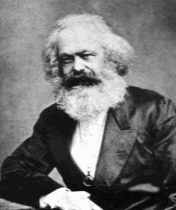|
Antagonistic Contradiction
From M. Rozental, Materialist
Dialectics: A Popular Outline of the Basic Laws of Materialistic Dialectics,
Moscow: Party Publisher of the Central Committee of the All-Union Communist
Party (Bolsheviks), 1937, pp. 55, 64, and 65.
From the beginning of capitalism, from its earliest
stages, all its contradictions have had an antagonistic—that is,
irreconcilable—character. But its contradictions develop, they have their lower
and higher stages….
The class of
landowners was liquidated as a result of the victory in the civil war. In the
further developments of the transitional period [from capitalism to socialism]
the capitalist elements in the villages were liquidated—the kulaks and private
capital in trade goods. It is understandable
that this overcoming of contradictions between the proletariat and these
exploiting classes could occur only in the form of the liquidation of these
classes which are hostile to the proletariat.
The
remaining two classes are the working class and the peasant class, in addition
to the intelligentsia. Because of historically established circumstances,
contradictions existed among all these classes and social strata. But these
contradictions were resolved by various methods and ways. Under the leadership
of the proletariat and with its help, the peasantry is on the path of the
socialist economy, and the intelligentsia has changed because its membership is
80 to 90% regenerated by recruitment from the working class, the peasantry, and
other working strata. Now, however, it serves the people, not the exploiting
classes. But why did the result turn out this way?
“What do these changes signify?
First they
signify that the dividing lines between the working class and the peasantry,
and between these classes and the intelligentsia, are being obliterated, and
that the old class exclusiveness is disappearing. This means that the distance
between these social groups is steadily diminishing.
Secondly
they signify that the economic contradictions between these social groups are
declining, become obliterated.
And lastly,
they signify that the political contradictions between them are also declining
and becoming obliterated.” (J. V. Stalin, On
the Draft Constitution of the U.S.S.R., Moscow: Party Publisher, 1936, p.
13. See J. V. Stalin, Leninism: Selected
Writings, New York: International Publishers, 1942, p. 384)
We see
that the movement of contradictions now has a character and tendency completely
opposed to that which could be observed in the analysis of capitalism.
Due
to their absolutely antagonistic character, the contradictions of capitalism
show themselves with greater and greater force in the processes of its
development. The unity of opposites is split apart, and forms two extremes
whose struggle leads not to life but to death. In the same way, contradictions
develop between Bolshevism and Menshevism.
Because
of their non-antagonistic character, and thanks to the correct politics of the
party, the contradictions between the working class and the laboring peasantry
are being abolished and are disappearing.
In
this way, there are before us examples of two completely opposite types of
contradictions. They are different in their content, in their form, in the
tendencies of their development, and finally, in the character of their
resolution.
It
should be kept in mind that the second type of contradiction, an example of
which is the contradiction between the proletariat and the peasantry, has
nothing in common with the reconciliation of opposites. Reconciliation of a
contradiction cannot in general be a source of development. On the
contrary, in the best case it can mean spinning your wheels, and as a rule, it
means moving backwards.
Reconciliation of the contradictions
between the proletariat and the peasantry would mean a petty bourgeois utopia
and illusory, but not real movement for socialism. What is more, it would mean
an unavoidable return to capitalism.
Struggle for the destruction of these
contradictions, for the revolutionary overcoming of them, for the
transformation of petty bourgeois private owners into socialist collectivists
allows real resolution of these contradictions and means real movement forward.
Such,
too, is the universal principle of development – the struggle of opposites, the
struggle between the new, the progressive, and the old, the reactionary, moves
forward. Powerful sources of all development are guaranteed in this struggle.
With
Lenin we find words which beautifully expresses this principle. “Unity … of
opposites,” he wrote, “is conditional, temporary, transient, relative. The
struggle of mutually excluding opposites is absolute, as absolute development,
movement.” (Lenin, Collected Works,
Russian edition, volume 13, p. 302)
All
history of the development of the non-organic and organic world, and all
history of social development confirms this law of movement.
| 

